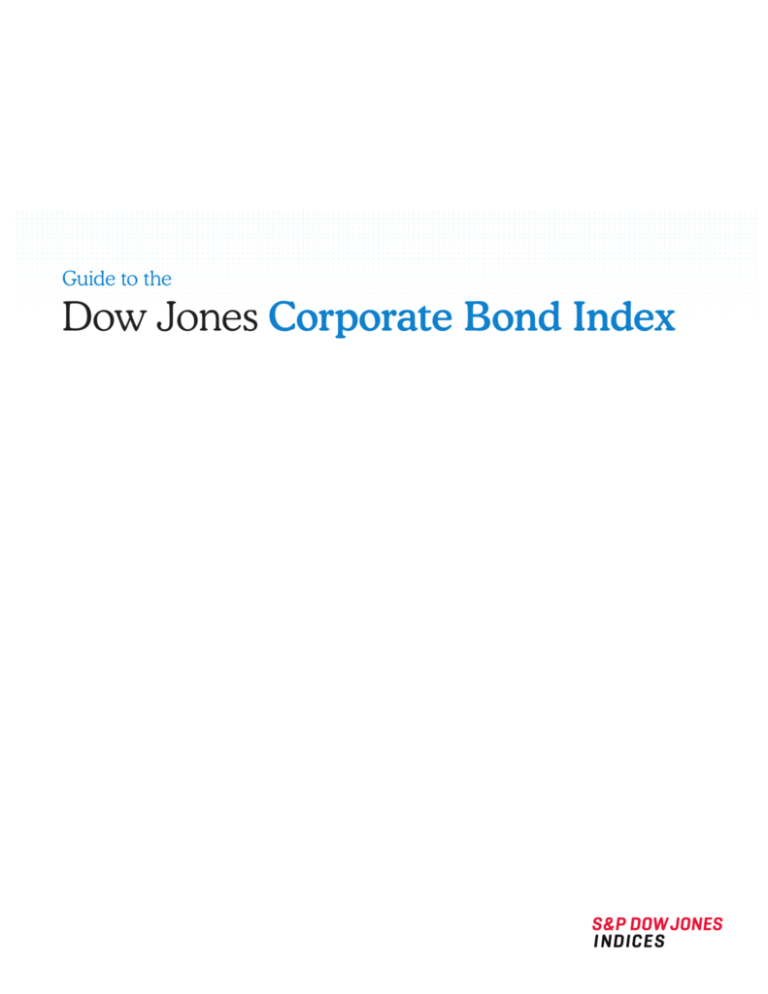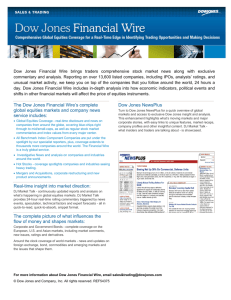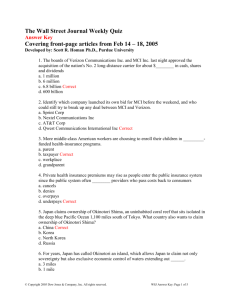
Guide to the
Dow Jones Corporate Bond Index
Guide to the
Contents
Dow Jones Corporate Bond Index SM
01. Introduction....................................... 3
02. Key Features...................................... 3
2.1 Base Date and Base Value .............................. 3
2.2 Calculation....................................................... 3
2.3 Methodology.................................................... 3
2.4Dissemination................................................... 4
2.5Weighting......................................................... 4
03. Index Construction............................ 4
3.1 Defining the Index Universe.............................. 4
04. Periodic Review ................................ 4
4.1 4.2
4.3 4.4 Index Composition .......................................... 4
Selection Process............................................ 4
Implementation................................................ 4
Bonds in Financial Distress ............................. 5
Appendix A ............................................. 5
Total Rate of Return Calculation Methodology.......... 5
2.
Guide to the
01. Introduction
2.3 Methodology
The Dow Jones Corporate Bond Index reflects the market
2.3.1 Maturity Cells
performance, on a total-return basis, of investment-grade bonds
issued by companies in the U.S. corporate bond market. The
index was designed to minimize the pricing and liquidity problems
Dow Jones Corporate Bond Index SM
The family includes indexes at the composite level and for four
maturity cells:
associated with most corporate bond indexes.
2 year
=
1.50—3.49 years
Included in the family are a 96-bond composite index and a series
5 year
=
3.50—7.49 years
of corporate-bond yield-curve bracket indexes at maturities of two,
10 year
=
7.50—17.49 years
five, ten and thirty years indexes. The Dow Jones Corporate Bond
30 year
=
17.50+ years
Index is further subdivided into Financials, Industrials and Utilities
sector indexes, each of which also has a yield-curve index series.
2.3.2 Sectors
02.Key Features
The selection universe for the index consists of all U.S.-issued
2.1 Base Date and Base Value
Service and/or Standard & Poor’s. Bonds that qualify for inclusion
The base date for the Dow Jones Corporate Bond Index is
December 31, 1996; the corresponding base value is 100.
Historical total-return index values have been calculated back to
the base date.
2.2 Calculation
2.2.1 Index Formula
corporate bonds rated investment grade by Moody’s Investors
in the universe are then classified into one of three sectors:
—Financials
—Industrials
—Utilities
The Financials sector includes banks, insurance companies
and financial service companies. The Utilities sector includes
Total returns are calculated daily for the Dow Jones Corporate Bond
gas companies, electric companies and water companies. The
Index. The index is calculated using a month-to-date method where
Industrials sector includes companies in all other industries.
the starting value of the index is equal to 100 on its inception date.
For example, if the index had a -0.12% return on its first day after
the base date, the index value for the first day would be
100*(1 – 0.0012) = 99.88.
A detailed explanation of the total return calculation is provided in
The combination of maturity cells and industry sectors provides
three industry sector yield curve index families and a composite
index yield curve, created from the 20 separately calculated indexes
underlying the Dow Jones Corporate Bond Index family, as shown in
the following table:
Appendix A.
Composite
Financials
Industrials
Utilities
2.2.2 Input Data
2 year
2 year
2 year
2 year
Daily bond bid prices are provided by Interactive Data Corporation.
5 year
5 year
5 year
5 year
These daily prices are provided at 4:00 p.m. Eastern Standard Time.
10 year
10 year
10 year
10 year
To avoid problems associated with market-weighted bond indexes,
30 year
30 year
30 year
30 year
the Dow Jones Corporate Bond Index and its subindexes are equal-
Total
Total
Total
Total
weighted. The daily total return of each index is the average of the
daily returns of all component bonds.
2.2.3 Weekends and Holidays
2.3.3 Constraints
Dow Jones Indexes calculates the Dow Jones Corporate Bond
—Bonds must be issued in the United States and
Index following the standard U.S. business calendar. On weekends
and holidays, the previous day’s closing price for each affected
bond is used for index calculation.
denominated in USD.
—Bonds must have a minimum outstanding value of $500
million to be eligible.
3.
Guide to the
—An issuer may have up to four bonds in the index, but
no more than one in each maturity cell.
—In order to enter a maturity cell, a bond’s remaining time
Dow Jones Corporate Bond Index SM
04.Periodic Review
4.1 Index Composition
to maturity must be at least three months longer than the
The goal of the Dow Jones Corporate Bond Index is to include
minimum maturity horizon for that cell. A bond already in
the most liquid bonds per maturity for each sector. All issues in
a cell may remain until the end of the month prior to the
the Dow Jones Corporate Bond Index remain in the index until
month its maturity would fall below the index’s minimum.
the month-end review, regardless of market condition changes.
—Only option-free (bullet bonds) are eligible. Structured
notes, bonds with embedded puts, and bonds with call
provisions and sinking funds are excluded from the index.
Make-whole bonds are included because they do not
have scheduled call dates and the redemption feature is
not interest-rate driven.
Factors considered in the review process include:
—New issues
—Credit rating changes
—Maturity of the issues
—Changes in outstanding amounts
—A bond must retain its investment-grade rating to remain
in the index.
4.2 Selection Process
—Bonds must have a fixed coupon to be eligible.
The component review process takes place no later than five
—Must be SEC registered. 144A, Regulation S and
business days prior to month-end. The final selection list will be
convertible bonds are excluded.
—Bonds are selected at month-end.
2.4 Dissemination
The Dow Jones Corporate Bond Index index return and statistics
are available at approximately 7:00 p.m. Eastern Time.
2.5 Weighting
Issues in the Dow Jones Corporate Bond Index are equally
weighted within the maturity cells, the industry sectors and the
composite index. The composite index contains 96 bonds at all
times, with 36 bonds in Financials, 48 bonds in Industrials and 12
bonds in Utilities.
distributed on the last business day of the month.
The review process starts with a review of the current
component basket, removing any bonds that fail to meet the
above-mentioned constraints.
Research on new on-the-run bonds is conducted to identify
those issues that meet all constraints. Of these bonds, any
issue that has an outstanding value greater than or equal to the
outstanding value of the smallest current index component in the
corresponding maturity bracket of its sector qualifies for the index.
Within each maturity bracket of each sector, eligible bonds are
ranked by the average of their 1-month and 3-month volumes.
Bonds with the highest average volumes are added until the
specified component count is satisfied.
For scenarios where no on-the-run bonds are eligible for selection
03.Index Construction
and additional components are needed, all qualified outstanding
bonds are considered for selection. These bonds are subject to
3.1
Defining the Index Universe
the same requirement for 1-month and 3-month average volume.
All corporate bonds that meet the constraints are included in the
Newly selected on-the-run bonds are retained in the index for a
selection universe for the Dow Jones Corporate Bond Index.
minimum of three months.
4.3 Implementation
Because the daily total return of the Dow Jones Corporate Bond
Index is an equally weighted average of the daily total returns of
all bonds in the index, replacing a bond does not require a divisor
adjustment. If a bond is to be replaced at month-end by another
4.
Guide to the
bond, the old bond’s total return is used to determine the total
return of the index on the last day of the month.
The new bond replaces the old bond after the month-end
total return figures are disseminated. The new bond is used to
Dow Jones Corporate Bond Index SM
Appendix A:
Total Rate-of-Return Calculation Methodology
Total return is calculated as the sum of price return and interest return:
construct the month-end yield curve for the Dow Jones Corporate
Price Return Calculation
Bond Index.
On the first day of the new month, that day’s total return from the
new bond is used to calculate the daily total returns for the Dow
Jones Corporate Bond Index.
Beginning-ofPeriod Market
Value
(Beginning Bid Price + Beginning
Accrued Interest) * Beginning Par Amount
Outstanding
End-of-Period
Market Value
(Ending Bid Price + Ending Accrued
Interest) * Beginning Par Amount
Outstanding + Coupon Payment
Total Return (%)
(End-of-Period Market Value / Beginningof-Period Market Value – 1) x 100
4.4 Bonds in Financial Distress
Dow Jones Indexes reserves the right to remove any issue
from the index at any time in response to any news that would
adversely affect the solvency and liquidity of that issue. If such an
event (including but not limited to a bankruptcy filing or a cut in
a bond’s rating that drops it below investment grade) occurs, the
securities that are removed will not be replaced in the index until
— Par amount outstanding is assumed to be constant
intra-month. Any change of par amount is reflected at the
beginning of the new month.
the next month-end index rebalancing.
5.
Guide to the
Dow Jones Corporate Bond Index SM
Except where noted, all information as of January 2013
GENERAL DISCLAIMER
Copyright © 2013 by S&P Dow Jones Indices LLC, a subsidiary of The McGraw-Hill Companies, Inc., and/or its affiliates. All rights reserved. Standard & Poor’s, and S&P are registered trademarks of Standard & Poor’s
Financial Services LLC (“S&P”), a subsidiary of The McGraw-Hill Companies, Inc. Dow Jones is a registered trademark of Dow Jones Trademark Holdings LLC (“Dow Jones”). Trademarks have been licensed to S&P Dow Jones
Indices LLC. Redistribution, reproduction and/or photocopying in whole or in part are prohibited without written permission. This document does not constitute an offer of services in jurisdictions where S&P Dow Jones
Indices LLC, Dow Jones, S&P or their respective affiliates (collectively “S&P Dow Jones Indices”) do not have the necessary licenses. All information provided by S&P Dow Jones Indices is impersonal and not tailored to the
needs of any person, entity or group of persons. S&P Dow Jones Indices receives compensation in connection with licensing its indices to third parties. Past performance of an index is not a guarantee of future results.
It is not possible to invest directly in an index. Exposure to an asset class represented by an index is available through investable instruments based on that index. S&P Dow Jones Indices does not sponsor, endorse, sell,
promote or manage any investment fund or other investment vehicle that is offered by third parties and that seeks to provide an investment return based on the performance of any index. S&P Dow Jones Indices makes no
assurance that investment products based on the index will accurately track index performance or provide positive investment returns. S&P Dow Jones Indices LLC is not an investment advisor, and S&P Dow Jones Indices
makes no representation regarding the advisability of investing in any such investment fund or other investment vehicle. A decision to invest in any such investment fund or other investment vehicle should not be made in
reliance on any of the statements set forth in this document. Prospective investors are advised to make an investment in any such fund or other vehicle only after carefully considering the risks associated with investing in
such funds, as detailed in an offering memorandum or similar document that is prepared by or on behalf of the issuer of the investment fund or other vehicle. Inclusion of a security within an index is not a recommendation
by S&P Dow Jones Indices to buy, sell, or hold such security, nor is it considered to be investment advice.
These materials have been prepared solely for informational purposes based upon information generally available to the public from sources believed to be reliable. No content contained in these materials (including index
data, ratings, credit-related analyses and data, model, software or other application or output therefrom) or any part thereof (Content) may be modified, reverse-engineered, reproduced or distributed in any form by any
means, or stored in a database or retrieval system, without the prior written permission of S&P Dow Jones Indices. The Content shall not be used for any unlawful or unauthorized purposes. S&P Dow Jones Indices and
its third-party data providers and licensors (collectively “S&P Dow Jones Indices Parties”) do not guarantee the accuracy, completeness, timeliness or availability of the Content. S&P Dow Jones Indices Parties are not
responsible for any errors or omissions, regardless of the cause, for the results obtained from the use of the Content. THE CONTENT IS PROVIDED ON AN “AS IS” BASIS. S&P DOW JONES INDICES PARTIES DISCLAIM ANY AND
ALL EXPRESS OR IMPLIED WARRANTIES, INCLUDING, BUT NOT LIMITED TO, ANY WARRANTIES OF MERCHANTABILITY OR FITNESS FOR A PARTICULAR PURPOSE OR USE, FREEDOM FROM BUGS, SOFTWARE ERRORS OR DEFECTS,
THAT THE CONTENT’S FUNCTIONING WILL BE UNINTERRUPTED OR THAT THE CONTENT WILL OPERATE WITH ANY SOFTWARE OR HARDWARE CONFIGURATION. In no event shall S&P Dow Jones Indices Parties be liable to any
party for any direct, indirect, incidental, exemplary, compensatory, punitive, special or consequential damages, costs, expenses, legal fees, or losses (including, without limitation, lost income or lost profits and opportunity
costs) in connection with any use of the Content even if advised of the possibility of such damages.
S&P Dow Jones Indices keeps certain activities of its business units separate from each other in order to preserve the independence and objectivity of their respective activities. As a result, certain business units of S&P Dow
Jones Indices may have information that is not available to other business units. S&P Dow Jones Indices has established policies and procedures to maintain the confidentiality of certain non-public information received in
connection with each analytical process.
In addition, S&P Dow Jones Indices provides a wide range of services to, or relating to, many organizations, including issuers of securities, investment advisers, broker-dealers, investment banks, other financial institutions
and financial intermediaries, and accordingly may receive fees or other economic benefits from those organizations, including organizations whose securities or services they may recommend, rate, include in model
portfolios, evaluate or otherwise address.
RULE-GEN-849-121712
6.








